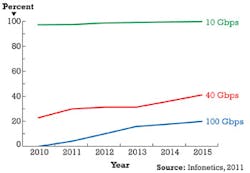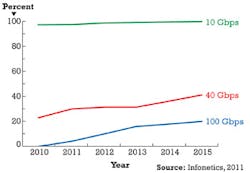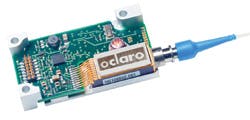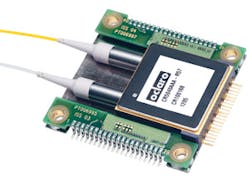The case for coherent-transponder subsystems
By PER HANSEN
Service providers are challenged with a large and growing demand for bandwidth at ever-decreasing market prices. Forecasts predict that bandwidth usage will grow threefold over a four-year period, while the total revenue from transporting that larger bandwidth will remain unchanged.
To help solve this challenge, coherent-transponder technology offers scalability and ease of operations. In addition, it enables a host of attractive network features such as simpler network engineering and remote automated wavelength turn-up and service provisioning. These benefits will help service providers meet bandwidth demand growth and reduce the total cost of owning and operating optical networks.
Transponders step up
The current transponder workhorse remains 10 Gbps, although 40 Gbps direct-detection modules (primarily based on DPSK and DQPSK) have been deployed in volumes for more than four years now. But in spite of later availability, 40-Gbps coherent transponders are expected to surpass 40-Gbps direct-detection this year in terms of the number of ports deployed. Meanwhile, 100-Gbps modules, which are being introduced as subsystems just this year, are predicted to ramp even more quickly and already forecasted to carry more traffic than their 40-Gbps siblings in 2013.
Infonetics’ most recent Global Service Provider Survey concludes that cost is the most critical metric for network operators to introduce coherent transponders. The total cost of ownership comparison is with current 10-Gbps alternatives and should take into account the higher common equipment utility that — through greater spectral densities — delays additional investments in common equipment.
Service providers also seek coherent approaches that enable more dynamic optical-network architectures that can easily be reconfigured to support growth and more frequent changes in traffic patterns while minimizing operational expenses. Remote turn-up and provisioning of wavelengths — as well as re-provisioning when traffic patterns change — rely on rapid automated dispersion compensation and optimization of the transponder settings. Similarly, such automated adaptation to the fiber characteristics supports a wider range of fiber types and qualities while enabling richer mesh networks that offer higher service resiliency.
Strategic network equipment differentiators
Digital coherent transponders built by equipment manufacturers based on discrete components initially brought 100-Gbps coherent technology to market, with the first reported deployment in 2009. Such early R&D investments secured an advantage in time to market, which vendors skillfully leveraged, as coherent quickly became recognized as an attractive scalable transponder technology.
In the initial stage of a technology’s lifecycle, early adopters typically are willing to pay a premium to lead the market adoption; they in turn realize a commensurate payback in terms of marketing or other value in addition to the tangible advantages of the new technology. The marketing advantage of a new technology can be considerable, as it was, for example, in the case of Sprint’s “pin drop” campaign highlighting their optical network in the late 1980s. More recently, The New York Stock Exchange leveraged the early adoption of 100-Gbps technology to brand itself as a leader in their industry.
Network equipment manufacturers have repeatedly leveraged advanced technology developed in-house to gain market share and will continue to do so. Typically, if and when the technology becomes widely adopted, market forces will create other sources that increase competition and drive down cost. As that occurs, a critical question for the network equipment manufacturer is whether — and, even more important, for how long — a proprietary technology offers enough differentiation and added value to its customers to make continued in-house development of that technology the best use of R&D resources. Obviously, this question must be revisited over time as technology and the competitive landscape evolve.
Outsourcing transponders, through the purchase of multisource-agreement (MSA) subsystems, offers potential cost savings as well as the opportunity for reallocating R&D resources to address higher-value challenges. History has proven this evolution from discrete components to integrated subsystems (including pluggables later in the technology lifecycle) at lower data rates such as 10 Gbps and 40 Gbps (see Figure). As several 100-Gbps MSA-compliant subsystems become available in the market during the next 12 months, we will see very competitive pricing and a rise in the share of 100-Gbps ports realized with off-the-shelf transponders.
Digital coherent technology maturing
The digital signal processing (DSP) that enables coherent reception of optical signals has evolved rapidly and is well understood today. Consequently, the number of DSP ASIC suppliers is growing. Likewise, all the needed optical components can be sourced from multiple suppliers. Thus, while performance and quality vary, all the components required to build coherent transponders are now generally available. That’s reflected in the current availability of 40-Gbps coherent-transponder subsystems and the fact that 100-Gbps transponder subsystems will be introduced by several suppliers this year.
Differentiation in network equipment, which leverages coherent technology, is thus evolving from availability from only a few suppliers in 2010 to many more coherent network equipment offerings only two years later, characterizing a market that’s transitioning from targeting early adopters to a broader customer base. Consequently, expect a more diverse supply chain as well as broader deployment of coherent transponders. Technology advances will continue to improve performance and, combined with the higher volumes, help drive down cost.
Coherent subsystem suppliers drive market expansion
MSA subsystems or other integrated transponder products enable a broad range of network equipment manufacturers with constrained R&D resources to offer both 40- and 100-Gbps coherent-enabled platforms. Cost, of course, is a critical parameter to win in the marketplace, and the advent of multiple suppliers of 100-Gbps coherent-transponder subsystems will create additional competition and help enable broader deployment and higher volumes.
A transponder subsystem supplier’s degree of vertical integration and the aggregation of production volumes are key factors for cost efficiency at the subsystem level. Vertical integration for optical components is an obvious and very executable advantage. Coherent transponders include several optical components that dominate the transponder cost: one or two integrable tunable-laser assemblies, an integrated PM-QPSK modulator, and an integrated dual-polarization intradyne coherent receiver. The OIF has developed recommendations for these three components as well as the module electro-mechanical characteristics (visit the OIF’s website for more on the relevant implementation agreements). PHOTOS 1, 2, and 3 show examples of such 100-Gbps optical transponder components. Vertical integration, including material technology through integrated devices, offers a lower cost basis as well as the ability and freedom to trade off and optimize performance for cost.
Beyond cost, features and performance are key attributes service providers consider when deciding whether to deploy coherent technology, according to the Infonetics survey. Network equipment manufacturers selecting a subsystem supplier should carefully consider both the features and performance that will be reflected in the resulting system as well as features that enable easy and rapid integration within that system.
Two of the advantages that subsystems offer are time to market (from decision to revenue) and low technology risk. While a transponder subsystem typically will not offer a first to market advantage, it will support a fast-follower model with a much lower capital and R&D investment. Similarly, feature-rich subsystems offer network equipment suppliers who have already launched systems based on discrete designs a rapid and low risk transition path to a multisourced volume-driven product. This transition frees internal R&D resources to focus on the next major system-differentiating advances.
High optical signal-to-noise ratio sensitivity and appropriate dispersion tolerance are obvious prerequisites for a high performance network platform. Robust chromatic dispersion and polarization-mode dispersion compensation implementations that enable rapid and accurate compensation are among the features that distinguish the best coherent-transponder subsystems. Likewise, large dynamic input power range, high tolerance to transients and nonlinearities as well as robust channel rejection for optical-receiver tuning (to permit selection and reception of the desired channel from among its neighbors without optical filtering) are sought after features. Subsystem implementations that deliver these characteristics and incorporate autonomous setup and operation ensure superior network equipment performance while minimizing the network equipment manufacturer’s development expense.
Easy and trouble-free integration of both hardware and software also is critical from the network equipment manufacturers’ perspective. Sound and reliable implementations rely on the experience of the subsystem development team. Expertise in coherent-transponder implementations and optical-system design as well as understanding how network characteristics vary in the field are prerequisites for engineering robust transponders.
Leveraging coherent broadly while scaling the technology
The technology and supply chain for 100-Gbps coherent transmission are rapidly maturing to support a larger market that seeks greater cost efficiencies while tackling the rapid growth in bandwidth demand. Coherent technology has the ability to penetrate all layers of the network that demand higher capacities. But such ubiquity will require further cost reduction.
The introduction of 100-Gbps coherent-transponder subsystems by several subsystem suppliers in 2012 will help drive competition and volumes to enable such cost reductions. However, the supply chain must also become more efficient, leveraging innovation as well as vertical integration to meet the market’s performance and cost targets.
While 100 Gbps will become pervasive and satisfy demand for some time, the attractiveness of coherent is in large part its scalability. The quest for higher capacity and bit rates will continue. Higher, further, and faster will remain goals for the optical networking industry.
PER HANSEN is vice president of product marketing for the ONS business unit of Oclaro Inc.
Past Lightwave Articles




